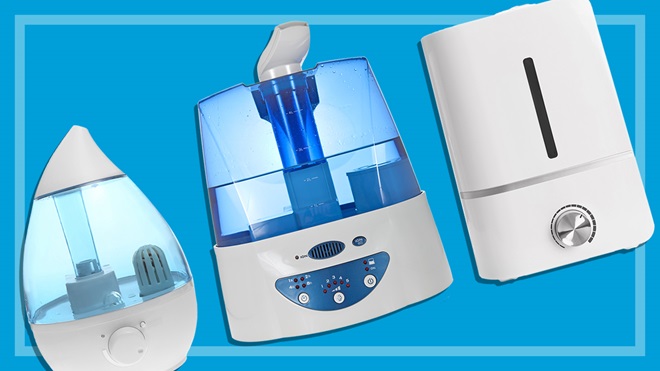While some areas of the country have been getting more moisture than they know what to do with, the colder months can be a time when dry air affects some people with allergies or sensitive skin conditions. If this is the case, a humidifier is a device that transforms water into mist or very tiny droplets to disperse in a room to help increase the humidity level.
Here we look more closely at how humidifiers work and whether one will suit your needs.
On this page:
- How do humidifiers work?
- What's the difference between a humidifier and a diffuser?
- Do you open the window when using a humidifier?
- What do all the modes on a humidifier do?
- How to choose a humidifier
- Do you need a dehumidifier instead?
How do humidifiers work?
Evaporative humidifiers work by evaporating water inside the humidifier which sends water vapour into the air, while non evaporative (or ultrasonic) humidifiers transmit moisture to the air in a visible or perceptible form without the need for a fan. Here are the common types of humidifiers you're likely to find in stores.
- Warm mist humidifiers (evaporative) heat water to a boil and emit the steam to release moisture into the air. Some types use mineral filters that trap water deposits, and these filters need changing.
- Cool mist humidifiers (evaporative) use a fan to blow air over a wet wick and move the humid air into the room.
- Ultrasonic humidifiers (non evaporative) use a vibrating diaphragm to convert water into a vapour. While a fan isn't required, some units do include a small fan to increase the spread of vapour throughout the room.
What's the difference between a humidifier and a diffuser?
We're on your side
For more than 60 years, we've been making a difference for Australian consumers. In that time, we've never taken ads or sponsorship.
Instead we're funded by members who value expert reviews and independent product testing.
With no self-interest behind our advice, you don't just buy smarter, you get the answers that you need.
You know without hesitation what's safe for you and your family.
And you'll never be alone when something goes wrong or a business treats you unfairly.
Learn more about CHOICE membership today
A humidifier breaks water down into mist, releasing it into the room to help increase the humidity. Diffusers release essential oils into the air for aromatherapy purposes. Some humidifiers have a small chamber for a few drops of essential oil, however the main purpose is to increase the humidity of the room. Diffusers on the other hand generally have an aim to disperse the aroma of the essential oil whereas a humidifier attempts to increase the overall humidity of the room.
A vaporiser humidifier uses heat to create the mist and disperse it to increase the humidity in the room. The fact that these devices use heat to transform the liquid to a mist makes them less than an ideal to use around babies or young children.
Do you open the window when using a humidifier?
The humidifiers you buy for your home are not particularly powerful and as the purpose is to raise the humidity of the room in a controlled manner, opening the window could make it difficult to reach and maintain the humidity level you desire.
However, if you feel that after running the humidifier for a period of time you've overshot your ideal level of humidity, it might be an option to open the windows to help lower the humidity level again, assuming the ambient environment has a low humidity.
What do all the modes on a humidifier do?
Some of the humidifiers we've tested include a night or sleep mode where the lights on the unit turn off or the display or screen is dimmed. Others have a fan which is set to the lowest setting after a certain time. Some models with a warm mist mode turn off automatically after several hours, while other models have programs to adjust the humidity to 55% and activate the warm mist function for a baby's room.
Other modes include keeping humidity between 56% and 70% for better breathing and to alleviate cold symptoms, while others maintain a humidity level of 60% with a warm mist.
How to choose a humidifier
Humidifiers come in various sizes (and prices), ranging from about $80–150 for a room that's less than 25m2, to $150–300 for a room that's more than 25m2. Before buying one, you need to figure out the size you need by measuring the dimensions of the room it'll be in (whether this is a bedroom or the living room, for example).
For sleeping areas, ultrasonic models are said to be quieter than evaporative ones. You should also choose a humidifier that's easy to maintain and clean and make sure you drain, rinse and dry it every day. Always follow the manufacturer's instructions with disinfecting and cleaning your humidifier and any residue build-up to make sure the moisture the machine emits is safe to breathe.
Do you need a dehumidifier instead?
Dehumidifiers work in the opposite way to a humidifier. If the humidity in your home is too high, a dehumidifier can remove excess moisture from the air, making it an option if you're looking to reduce mould and mildew in your home.
Stock images: Getty, unless otherwise stated.



